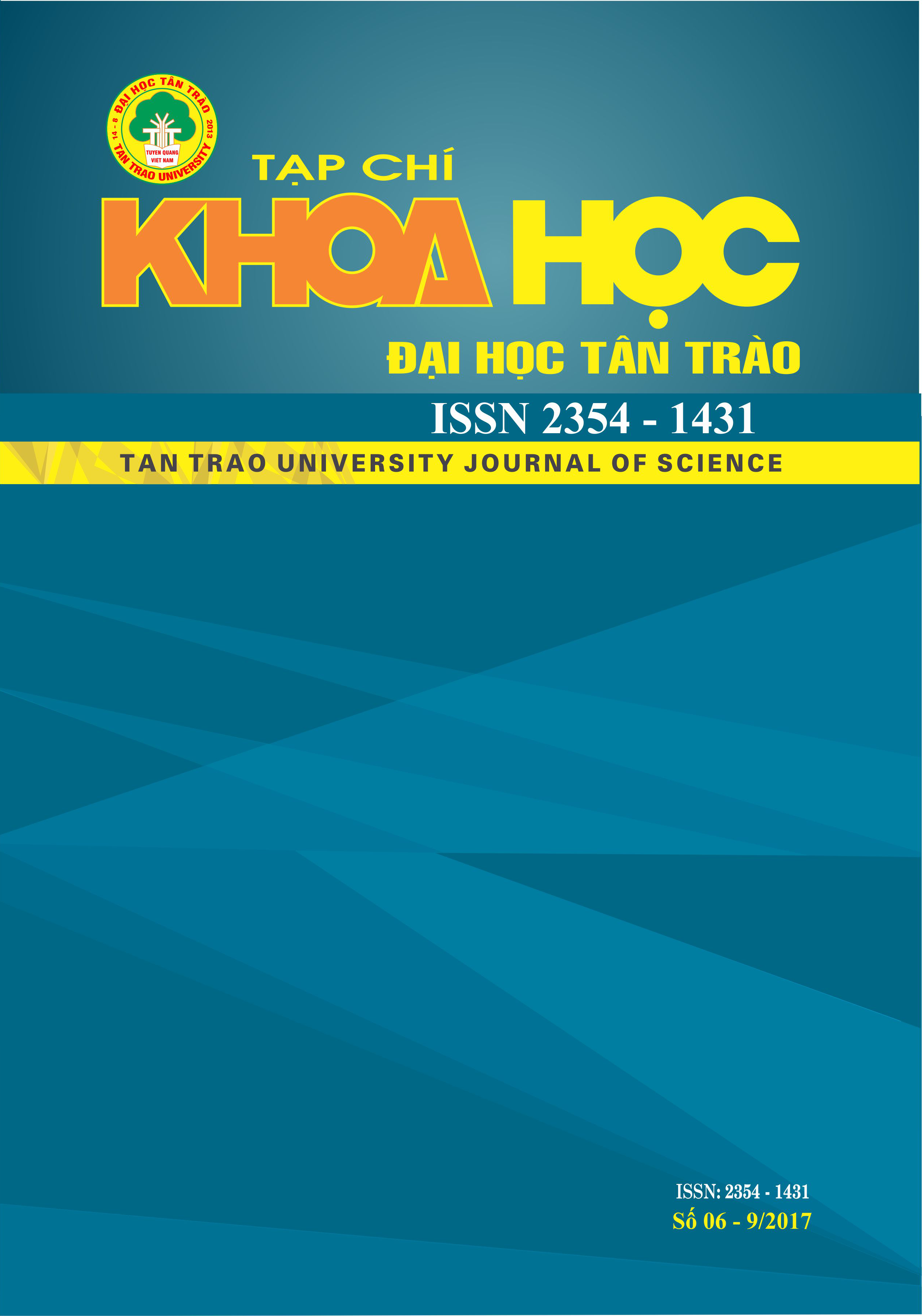Đa dạng tài nguyên cây làm thuốc tại khu bảo tồn thiên nhiên Na Hang, tỉnh Tuyên Quang
DOI:
https://doi.org/10.51453/2354-1431/2017/162Tóm tắt
In Na Hang Nature Reserve there was identified 647 medicinal plant species belonging to 137 families, 4 vascular divisions: Lycopodiophyta with 3 species, 2 families; Polypodiophyta with20 species, 12 families; Pinophyta with 6 species, 4 families; Magnoliophyta with 618 species, 119 families. Concerning the diversity index: the family index: 4.72; the genus index: 1.49; the genus index/the family index: 3.16. In Na Hang Nature Rserve 10 families more species occupying 7.30% of the total families of medicinal plants with the total of species occupying 31.68% and 28.64% of the total of genus. The family more diverse is Asteraceae with 32 species, occupying 4.95% of the total of medicinal plants identified; following is Rubiaceae with 28 species (4.33%), Euphorbiaceae with 26 species (4.02%); Moraceae with 23 species (3.55%); Cucurbitaceae, Verbenaceae with the same number of species 18 (2.78%); Araceae with 17 species (2.63%); Zingiberaceae with 16 species (2.47%); Urticaceae with 15 species (2.32%); and the last are families Poaceae of species 12 (1.85%) in the total of species. 10 genera more diverse with 59 species (9.12% of the total of medicinal plants), Ficus (Moraceae) is more diverse with 15 species (2.32% of the total of medicinal plants) and another genera with from 4 to 7 species. In Nature Reserve of Na Hang we have confirmed the distribution of 30 precious and rare and endangered species priorto the conservation: 23 species in Vietnam Red Data Book (2007): VU - 16 species, EN - 07 species; 17 species in Red List of medicinal plant of Vietnam (2006):VU - 10 species, EN - 6 species and CR – 01 species; 07 species in IUCN Red List (2014): LR - 06 species and VU – 01 species.
Tải xuống
Tài liệu tham khảo
1. Bộ Khoa học và Công nghệ, Viện Khoa học và Công nghệ Việt Nam (2007), Sách Đỏ Việt Nam. Phần II: Thực vật, Nxb Khoa học Tự nhiên và Công nghệ;
2. Bộ Nông nghiệp và Phát triển Nông thôn (2000), Tên cây rừng Việt Nam, Nxb Nông nghiệp, Hà Nội;
3. Chính phủ nước CHXHCN Việt Nam (2006), Nghị định 32/2006/NĐ-CP của Chính phủ về quản lý thực vật rừng, động vật rừng nguy cấp, quý hiếm;
4. Nguyễn Tập (2006), Danh lục đỏ cây thuốc Việt Nam; Tạp chí Dược liệu 3(10);
5. Nguyễn Nghĩa Thìn (1997), Các phương pháp nghiên cứu đa dạng sinh học, Nxb Đại học Quốc gia Hà Nội;
6. Nguyễn Nghĩa Thìn (chủ biên), Đặng Quyết Chiến (2006), Đa dạng thực vật Khu bảo tồn thiên nhiên Na Hang, tỉnh Tuyên Quang, Nxb Nông nghiệp, Hà Nội;
7. Nguyễn Anh Tuấn, Trần Huy Thái (2012), Đặc điểm sinh thái và phân bố của loài biến hóa núi cao (Asarum balansae Franch.) tại Bản Bung, huyện Na Hang, tỉnh Tuyên Quang. Tạp chí Sinh học, 34(1): 75-81;
8. Nguyễn Anh Tuấn, Trần Huy Thái, Jenn-Che Wang, Chang-Tse Lu (2012), Bổ sung loài Asarum yunnanense T. Sugaw., Ogisu & C. Y. Cheng (họ Mộc hương - Aristolochiaceae) cho hệ thực vật Việt Nam. Tạp chí Sinh học, 34(4): 441-445;
9. UBND tỉnh Tuyên Quang (1994), Quyết định số 274/1994/QĐ-UBND ngày 9/5/1994 của Chủ tịch Uỷ ban nhân dân tỉnh Tuyên Quang về việc phê duyệt thành lập khu Bảo tồn thiên nhiên Na Hang, tỉnh Tuyên Quang;
10.Hill M. and Kemp N. (1996), Na Hang Nature Reserve, Ban Bung sector.Report 8.Site description and conservation evaluation. Frontier Vietnam, Environmental Research. Hanoi;
11. Hill M. and Kemp N. (1997), Na Hang Nature Reserve, Tat Ke sector. Report 9.Site description and conservation evaluation. Frontier Vietnam, Environmental Research. Hanoi;
12. IUCN (2014), The Red List of threatened species. World Conservation Press.
Tải xuống
Đã Xuất bản
Cách trích dẫn
Số
Chuyên mục
Giấy phép

Tác phẩm này được cấp phép theo Giấy phép Quốc tế Creative Commons Attribution-ShareAlike 4.0 .
Bài báo được xuất bản ở Tạp chí Khoa học Đại học Tân Trào được cấp phép theo giấy phép Ghi công - Chia sẻ tương tự 4.0 Quốc tế (CC BY-SA). Theo đó, các tác giả khác có thể sao chép, chuyển đổi hay phân phối lại các bài báo này với mục đích hợp pháp trên mọi phương tiện, với điều kiện họ trích dẫn tác giả, Tạp chí Khoa học Đại học Tân Trào và đường link đến bản quyền; nêu rõ các thay đổi đã thực hiện và các nghiên cứu đăng lại được tiến hành theo cùng một bản quyền.
Bản quyền bài báo thuộc về các tác giả, không hạn chế số lượng. Tạp chí Khoa học Tân Trào được cấp giấy phép không độc quyền để xuất bản bài báo với tư cách nhà xuất bản nguồn, kèm theo quyền thương mại để in các bài báo cung cấp cho các thư viện và cá nhân.
Mặc dù các điều khoản của giấy phép CC BY-SA không dành cho các tác giả (với tư cách là người giữ bản quyền của bài báo, họ không bị hạn chế về quyền hạn), khi gửi bài tới Tạp chí Khoa học Đại học Tân Trào, tác giả cần đáp ứng quyền của độc giả, và cần cấp quyền cho bên thứ 3 sử dụng bài báo của họ trong phạm vi của giấy phép.






